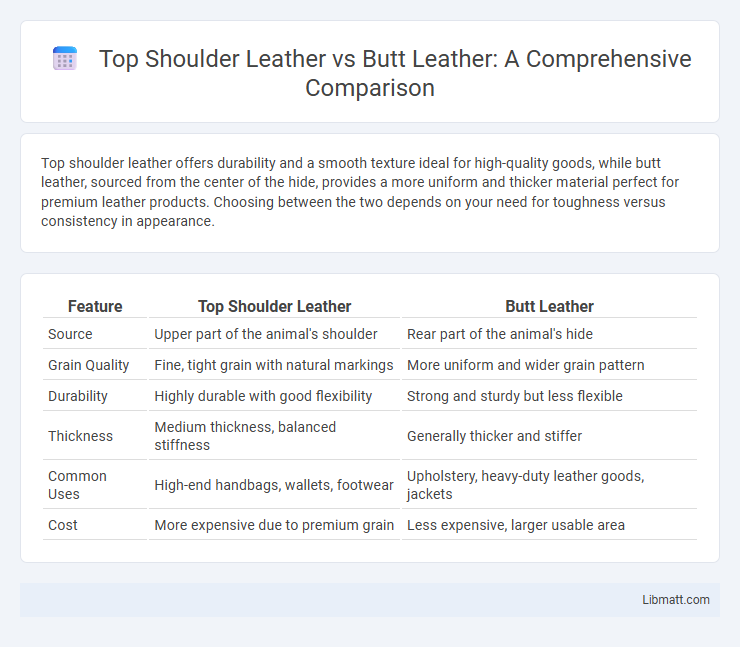Top shoulder leather offers durability and a smooth texture ideal for high-quality goods, while butt leather, sourced from the center of the hide, provides a more uniform and thicker material perfect for premium leather products. Choosing between the two depends on your need for toughness versus consistency in appearance.
Table of Comparison
| Feature | Top Shoulder Leather | Butt Leather |
|---|---|---|
| Source | Upper part of the animal's shoulder | Rear part of the animal's hide |
| Grain Quality | Fine, tight grain with natural markings | More uniform and wider grain pattern |
| Durability | Highly durable with good flexibility | Strong and sturdy but less flexible |
| Thickness | Medium thickness, balanced stiffness | Generally thicker and stiffer |
| Common Uses | High-end handbags, wallets, footwear | Upholstery, heavy-duty leather goods, jackets |
| Cost | More expensive due to premium grain | Less expensive, larger usable area |
Introduction to Leather Types: Shoulder vs Butt
Top shoulder leather, derived from the upper part of the hide near the shoulder, offers a balance of strength and flexibility ideal for durable goods like bags and jackets. Butt leather, sourced from the central rear portion of the hide, is prized for its uniform thickness and tight grain, providing superior durability and a premium finish. Both types vary in texture and resilience, influencing their suitability for different high-quality leather products.
Defining Shoulder Leather: Characteristics and Uses
Shoulder leather, derived from the upper part of the cowhide, features a natural grain with slight imperfections, making it highly durable and flexible for various applications. Its thickness and toughness suit products requiring both strength and aesthetic appeal, such as jackets, handbags, and upholstery. Compared to butt leather, shoulder leather is more textured and cost-effective, offering practical benefits without sacrificing quality.
What Is Butt Leather? Key Features and Applications
Butt leather is a premium full-grain leather derived from the rear part of a cowhide, known for its toughness, durability, and smooth surface with minimal scars or imperfections. Unlike top shoulder leather, which comes from the shoulder area and exhibits more pronounced grain and natural markings, butt leather offers a more uniform texture ideal for high-end leather goods such as wallets, belts, and luxury footwear. Its superior strength and fine grain make butt leather highly sought after in applications requiring both aesthetic appeal and long-lasting performance.
Durability Comparison: Shoulder vs Butt Leather
Butt leather, sourced from the rear part of the hide, offers superior durability compared to top shoulder leather due to its thicker grain and fewer imperfections. The dense fiber structure in butt leather enhances resistance to wear and tear, making it ideal for heavy-use items. Your choice between top shoulder and butt leather should consider this durability factor, especially for products requiring long-lasting performance.
Flexibility and Workability: Which Leather Wins?
Top shoulder leather offers moderate flexibility and durability, making it suitable for projects requiring both strength and some pliability. Butt leather, on the other hand, is thicker, stiffer, and more robust, providing superior workability for heavy-duty applications but less flexibility. Your choice depends on whether you prioritize ease of shaping or durability in your leatherworking project.
Surface Texture and Grain: Notable Differences
Top shoulder leather features a more pronounced grain and tighter surface texture, offering enhanced durability and resistance to wear. Butt leather presents a smoother, flatter grain with fewer natural markings, making it preferred for high-end leather goods that require a refined finish. These textural and grain differences impact the leather's aesthetic appeal and performance in various applications.
Cost Factors: Is Shoulder or Butt Leather More Economical?
Top shoulder leather typically costs less than butt leather due to its smaller size and higher variability in grain quality, making it more economical for production. Butt leather, derived from the central part of the hide, offers superior durability and uniformity, often justifying a higher price point in premium leather goods. Manufacturers balance these cost factors based on the intended use, with shoulder leather favored for budget-friendly products and butt leather preferred in luxury items.
Best Uses for Shoulder Leather in Crafting
Shoulder leather, known for its strength and flexibility, is ideal for crafting durable items like bags, wallets, and belts that require both toughness and a smooth finish. Unlike butt leather, which is thicker and better suited for heavy-duty applications such as saddles and footwear, shoulder leather provides a balanced combination of suppleness and resilience perfect for everyday accessories. Your projects benefit from shoulder leather's natural grain and resistance to stretching, ensuring longevity without sacrificing style.
Ideal Projects for Butt Leather
Butt leather, known for its durability and thickness, is ideal for heavy-duty projects like belts, saddles, and high-quality footwear that require strong, long-lasting materials. Its dense grain structure offers excellent abrasion resistance, making it suitable for work gear and protective wear. When choosing leather for your project, butt leather ensures superior strength compared to top shoulder leather, which is better for lighter applications.
Choosing the Right Leather: Shoulder vs Butt for Your Needs
Choosing between top shoulder and butt leather depends on your specific needs for durability and appearance. Top shoulder leather offers a balance of strength and flexibility, making it ideal for items requiring moderate wear resistance, while butt leather provides superior toughness and a smoother grain, perfect for high-end leather goods that need long-lasting durability. Understanding your project's demands will help you select the leather that best suits your style and functional requirements.
Top shoulder vs butt leather Infographic

 libmatt.com
libmatt.com